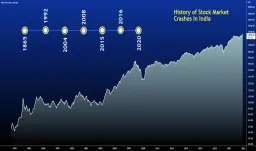High-Priced VS Low-Priced Stocks: Which Delivers Better Returns?

It’s crucial to monitor the value of the equities as well as their price when investing in the stock market. In general, many investors choose stocks with lower stock market prices. Keep in mind that equities with lower prices typically have greater risk than those with higher prices. Low-priced equities are not precisely defined, though. Let us explore the distinction between low-priced and high-priced stocks and which stocks deliver better returns in detail.
However, according to numerous financial professionals, equities with a price of less than Rs 20 are regarded as low-priced stocks. On the other hand, high-priced equities are those with a price tag of more than Rs 500.
Potential investors are drawn to the relatively cheaper stocks since they can purchase a greater number in a smaller quantity.
This article will explain the distinction between low-priced and expensive stocks and which stocks deliver better returns in detail.
Difference between High and Low priced stocks
Here are the list of differences between High and Low priced stocks :
Risks
Low-priced equities are more risky than high-priced stocks when it comes to risk. The fact that low-priced equities are traded seldom is the main factor contributing to their high risk. They have long participated actively in the stock market, although they might not be doing well. Because of this, investors can purchase them for a minimal cost. This raises their risk factor as a result. High-priced equities, on the other hand, are less hazardous because of their reputation and market size. As a result, they are regarded as safe for investment.
Regulations
The Security and Exchange Board of India (SEBI) keeps track of all stock market activity. Because they are the focus of attention in the market, high-priced equities receive more scrutiny, whereas low-priced stocks receive little attention from investors. Most of the time, they do not even have a file with SEBI and are not registered on important stock markets.
A lack of reliable information is created by fewer laws and compliances while making investment decisions. However, despite the rights and benefits that come with high-priced stocks, how do investors pay attention to lower-priced equities?
Investors frequently believe that if they have more money, they can purchase a greater variety of inexpensive stocks, favouring quantity above quality.
A stock’s lower valuation, in the opinion of some investors, increases the likelihood that it will double in value and produce larger returns. Additionally, based on the current trend, while having a cheaper price, they have the potential to produce enormous profits.

When choosing an investment, some investors place special emphasis on the Price to Equity (P/E) ratio. The P/E ratio of the low-priced stocks is lower, which means the investor must pay less money to own shares of a certain company.
Because of this, investors pay more attention to low-priced companies than they do to expensive ones.
Volatility
The average stock price will fluctuate when there is volatility. Since low-priced stocks are less expensive, they are viewed as being more volatile. Since they frequently rise and fall in value over short periods of time, it stands to reason that their prices will drop quickly.
As a result, investors seeking safety and reliable stocks do not like cheap stocks. On the other hand, expensive stocks behave differently from inexpensive equities.
They are thought to be less volatile because of their market value. As a result, investors buy expensive stocks because they have a reputation for producing profits over the long term.
Affordability
All new investors who have recently entered the stock market can typically afford the low-priced equities.
Due to their simplicity in purchase and management, novice investors favour low-priced stocks to those that are highly priced. On the other hand, there are some limitations on the entry of new investors in the case of blue-chip stocks.
Due to their portfolios or other significant factors, many new investors are unable to grow their investment in expensive companies.
Which stocks deliver better returns to investors (High-priced or Low-priced)?
For any investor, returns are the factor that matters most when it comes to investments. The best indicator isn’t necessarily the stock’s retail price.Low-priced stocks occasionally have a possibility to increase in value and provide investors with rewards, but this is extremely unlikely.
High-priced equities, on the other hand, are worth more than Rs 500. The majority of investors trust these stocks because they have the potential to provide better returns. Pricey stocks have proven to be highly profitable in both the short- and long-term. Investors must initially make a sizable investment for higher-priced equities. Even though expensive equities have a potential of declining in value, they typically offer very large returns. If the price drops as a result of bonus or rights issues, they recoup and make respectable gains. As a result, it would enable you to multiply the investor’s capital.
The bottom line
There are a lot of different factors to consider when trying to determine whether high-priced or low-priced stocks will deliver better returns. However, at the end of the day, the most important factor is always going to be the underlying fundamental strength of the company. If you’re investing in a company that has strong fundamentals, then it doesn’t really matter what the share price is – you’re still going to see good returns. However, if you’re investing in a company with weak fundamentals, then even if the share price is low, you’re not going to see good returns. So, ultimately, when deciding between high-priced and low-priced stocks, you need to focus on the quality of the company rather than the share price. If you can find good companies with strong fundamentals regardless of their share price, then you’ll be well on your way to achieving great returns on your investment.
Follow us on Instagram.









